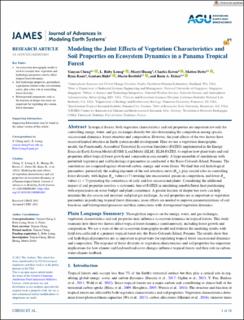| dc.description.abstract | In tropical forests, both vegetation characteristics and soil properties are important not only for controlling energy, water, and gas exchanges directly but also determining the competition among species, successional dynamics, forest structure and composition. However, the joint effects of the two factors have received limited attention in Earth system model development. Here we use a vegetation demographic model, the Functionally Assembled Terrestrial Ecosystem Simulator (FATES) implemented in the Energy Exascale Earth System Model (E3SM) Land Model (ELM), ELM-FATES, to explore how plant traits and soil properties affect tropical forest growth and composition concurrently. A large ensemble of simulations with perturbed vegetation and soil hydrological parameters is conducted at the Barro Colorado Island, Panama. The simulations are compared against observed carbon, energy, and water fluxes. We find that soil hydrological parameters, particularly the scaling exponent of the soil retention curve (Bsw), play crucial roles in controlling forest diversity, with higher Bsw values (>7) favoring late successional species in competition, and lower Bsw values (1 ∼ 7) promoting the coexistence of early and late successional plants. Considering the additional impact of soil properties resolves a systematic bias of FATES in simulating sensible/latent heat partitioning with repercussion on water budget and plant coexistence. A greater fraction of deeper tree roots can help maintain the dry-season soil moisture and plant gas exchange. As soil properties are as important as vegetation parameters in predicting tropical forest dynamics, more efforts are needed to improve parameterizations of soil functions and belowground processes and their interactions with aboveground vegetation dynamics. | en_US |

